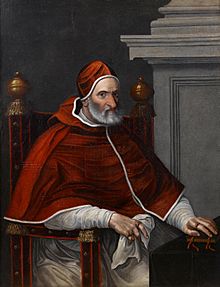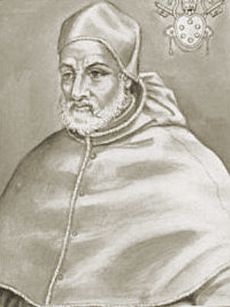Pope Pius IV facts for kids
Quick facts for kids Pope Pius IV |
|
|---|---|
| Bishop of Rome | |

Portrait by Scipione Pulzone, c. 1560s
|
|
| Church | Catholic Church |
| Papacy began | 25 December 1559 |
| Papacy ended | 9 December 1565 |
| Predecessor | Paul IV |
| Successor | Pius V |
| Orders | |
| Consecration | 20 April 1546 by Filippo Archinto |
| Created Cardinal | 8 April 1549 |
| Personal details | |
| Birth name | Giovanni Angelo Medici |
| Born | 31 March 1499 Milan, Duchy of Milan |
| Died | 9 December 1565 (aged 66) Rome, Papal States |
| Previous post |
|
| Coat of arms | |
| Other Popes named Pius | |
| Papal styles of Pope Pius IV |
|
|---|---|
 |
|
| Reference style | His Holiness |
| Spoken style | Your Holiness |
| Religious style | Holy Father |
| Posthumous style | None |
Pope Pius IV (born Giovanni Angelo Medici) was the leader of the Catholic Church and the ruler of the Papal States from 1559 until his death in 1565. He was born in Milan, Italy, on March 31, 1499. His family believed they were related to the famous House of Medici from Florence and used the same family symbol. Even though historians today haven't found clear proof of this link, the Medici family in Florence accepted their claim in the early 1500s.
Before becoming Pope, he was appointed Archbishop of Ragusa by Pope Paul III. He also went on important diplomatic trips to Germany and Hungary. As Pope, Pius IV was in charge of the final meetings of the Council of Trent. His nephew, Charles Borromeo, was a very important helper and adviser to him. Pope Pius IV also started many building projects in Rome, like improving the city's water supply.
Contents
Early Life and Career
Giovanni Angelo Medici was born in Milan on March 31, 1499. He was one of eleven children. His older brother was a famous soldier named Gian Giacomo Medici. Giovanni was also the uncle of Charles Borromeo, who would later become a saint.
Giovanni studied philosophy and medicine in the city of Pavia. He then went to the University of Bologna. There, he became known as a very good jurist, which means an expert in law. On May 11, 1525, he earned his doctorate in both church law (canon law) and civil law.
In 1527, Medici moved to Rome. He quickly became a favorite of Pope Paul III. This helped him get promoted quickly. He became the governor of several towns and was made the archbishopric of Ragusa from 1545 to 1553.
Becoming a Cardinal
On April 8, 1549, Pope Paul III made Medici a cardinal. This is a very high rank in the Catholic Church. He received his red hat and official title on May 10. As a cardinal, he was sent on important diplomatic missions. These trips took him to Germany and Hungary to represent the Pope.
Time as Pope
His Election
After Pope Paul IV died, Giovanni Angelo Medici was chosen as the new Pope. This happened on December 25, 1559. He took the name Pius IV. His official installation as Pope was on January 6, 1560.
One of his first big actions was to forgive people who had caused trouble after the previous Pope's death. He also brought to justice some of the previous Pope's relatives who had committed crimes.
The Council of Trent
The Council of Trent was a very important meeting of Catholic leaders. It had been stopped for a while, but Pope Pius IV called it back together for its third and final session. This happened on January 18, 1562. It was a difficult time, and Pope Pius IV needed great skill to settle the issues. Different countries had their own demands, and they were ready to work together against Rome's wishes.
However, Pope Pius IV, with help from Cardinal Morone and Charles Borromeo, handled the situation well. He made smart decisions and some compromises. This led the council to a good end for everyone involved and strengthened the Pope's authority. The council's decisions were confirmed by a special papal order called a "Benedictus Deus" on January 26, 1564. The famous Creed of Pius IV, also known as the Tridentine Creed, became a key statement of Catholic beliefs.
Pope Pius IV was generally a moderate and easygoing person. Any strict actions during his time as Pope were usually suggested by others, not something he wanted to do himself. For example, in 1564, he warned Jeanne d'Albret, the Queen of Navarre, about her Calvinist beliefs. But he withdrew the warning when Charles IX of France protested strongly. In the same year, he allowed people in Austria and Bohemia to receive communion in both bread and wine forms.
Building Projects
One of Pope Pius IV's biggest interests was building. He spent a lot of money making Rome more beautiful. He built the new Porta Pia and Via Pia, which were named after him. He also expanded a part of Rome called Borgo. He continued work on restoring, building, and strengthening defenses in other parts of the Papal States.
Some people, like the artist Giorgio Vasari, felt that Rome became less grand during his time. Vasari wrote in 1567 that the city's greatness was reduced by simple living and dress. He felt Rome was becoming poor.
New Cardinals
Pope Pius IV appointed 46 new cardinals during his time as Pope. He held four special meetings called consistories for this. He also made three of his nephews cardinals, including Charles Borromeo. He also made Ugo Boncompagni a cardinal, who later became Pope Gregory XIII.
In 1565, Pope Pius IV offered the cardinal position to Jean Parisot de Valette, the grand master of the Order of Malta. This was to honor him for defending Malta against the Ottoman Empire. However, Jean Parisot de La Valetta politely refused the offer.
Architectural Achievements
During Pope Pius IV's rule, the famous artist Michelangelo rebuilt the church of Santa Maria degli Angeli e dei Martiri. This church was built inside the ancient Diocletian's Baths. Pope Pius IV also had the beautiful Villa Pia built in the Vatican Gardens. This villa was designed by Pirro Ligorio and is now the home of the Pontifical Academy of Sciences. He also asked Michelangelo to design and build the Porta Pia, a famous gate in Rome.
Pope Pius IV also ordered public construction to improve Rome's water supply. This helped bring more fresh water to the city's people.
Beatifications
During his time as Pope, Pius IV did not declare any saints. However, he did beatify one person, Gundisalvus of Amarante, on September 16, 1561. Beatification is a step towards becoming a saint.
His Death
Pope Pius IV died on December 9, 1565. He had a high fever and an infection in his urinary tract. He was first buried in Saint Peter's Basilica. Later, on January 4, 1583, his remains were moved to Santa Maria degli Angeli e dei Martiri. His successor as Pope was Pope Pius V.
Pius IV had many health problems, including gout. This made it hard for him to move around. An observer named Giacomo Soranzo noted in 1565 that the Pope had a lot of natural energy. However, his gout made it difficult for him to move his legs, shoulders, arms, and hands. Because of this, he often had to be carried in a special chair called a sedia gestatoria instead of walking. Pope Pius IV also had a serious illness in 1564, but he recovered from it.
Eight days before he died, the Pope became ill again with a constant fever. Charles Borromeo, his nephew, arrived in Rome on the evening of December 8. He was with the Pope when he passed away, along with Saint Philip Neri.
See also
 In Spanish: Pío IV para niños
In Spanish: Pío IV para niños
- Cardinals created by Pius IV
- House of Medici
- List of popes from the Medici family


